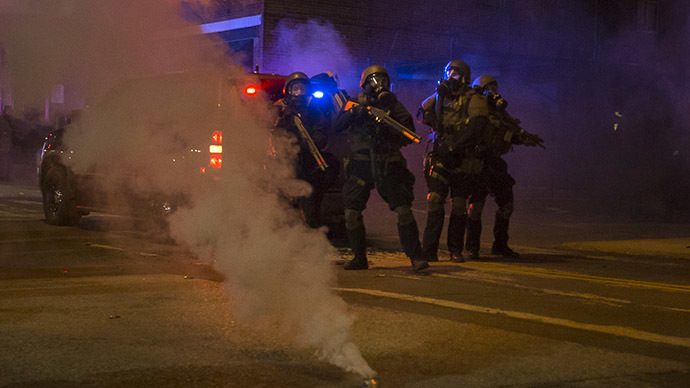Justice Dept. blasts Ferguson police response to protests in leaked report

Police trying to control the Ferguson protests had contradictory policies, violated free speech rights, and antagonized people with military-style tactics, said a new Justice Department report summary acquired by the St. Louis Post-Dispatch.
The full report is expected to contain 45 findings regarding the response of four police agencies in the first 16 days after Ferguson Police Officer Darren Wilson fatally shot Michael Brown, 18, in a controversial confrontation on August 9, 2014.
The draft report suggests that the protests after Brown’s death were aggravated by the community’s hostility toward Ferguson police and worsened when authorities didn’t quickly divulge details about his death.
“Had law enforcement released information on the officer-involved shooting in a timely manner and continued the information flow as it became available, community distrust and media skepticism would most likely have been lessened,” the document states, reported the St. Louis Post-Dispatch.
READ MORE: 2 plead guilty in Ferguson bomb plot case
A grand jury and the Justice Department both declined to prosecute Wilson, who later resigned, and another Justice Department report released in March was critical of Ferguson police and the city’s profit-driven municipal court system. Those reports led to the resignations and firings of six Ferguson officials, including the chief of police and a municipal court judge.
The new, unreleased report chastised the Ferguson Police Department for failing to manage community reaction and develop a long-term strategy, as well as for maintaining poor relationships with the black community — a problem that “over time led to devastating effects.”
“The protests were ... also a manifestation of the long-standing tension between the Ferguson (Police Department) and the African-American community,” the report summary stated.
The summary found a flawed response across agencies. It was critical of the police use of canine units, which “exacerbated tensions by unnecessarily inciting fear and anger among amassing crowds,” pointed out the inconsistent use of force and arrests, and noted the use of tear gas, “deployed without proper warning” in places where people couldn’t retreat.
The report was also critical of the arbitrary use of the “moving order” or “five second rule” by police, which the Justice Department said violated citizens’ right to assembly and free speech.
The Justice Department also found that the use of police snipers on top of tactical vehicles, and rifle sights to monitor the crowd, was an “inappropriate crowd control measure.” It was critical of officers wearing defensive and tactical equipment visible during peaceful protests. The department recommended that armored vehicles should only be visible when responding to shots fired.
READ MORE: St. Louis alderman wants answers after cops use Taser on protesters (VIDEO)
The summary of a longer report, subject to revision, is scheduled for delivery to police officials in Ferguson, St. Louis County, St. Louis and Missouri Highway Patrol later this week, according to the Post-Dispatch. Its 45 findings will be accompanied by recommendations.
The summary addresses failures in tactics, and behaviors rather than targeting personnel, but it did find fault with varying levels of training and different police philosophies at the four agencies. It also said the agencies were ill-prepared to handle the effects of social media, as they had “underestimated the impact social media had on the incident and the speed at which both facts and rumor were spread and failed to have a social media strategy.”
Also noted was that “officers were not prepared for the volume and severity of personal threats…this includes threats of violence against family members and fraud associated with technology-based attacks.”












